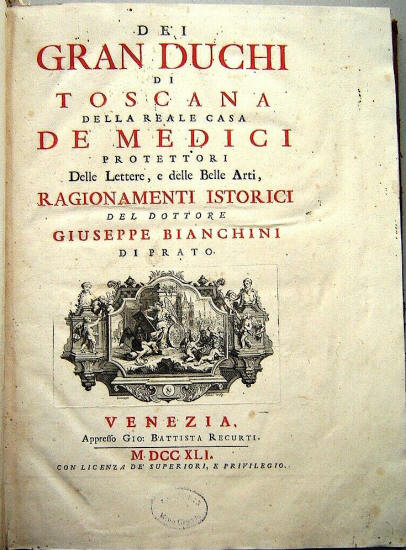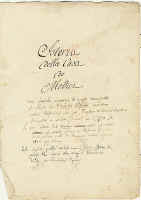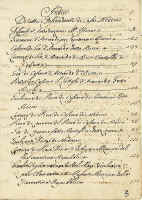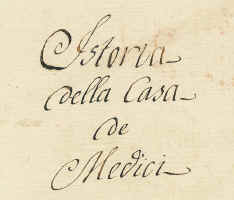|
Although a panegyric to the Medici dynasty, this ms. was written in beautiful early-18th century
Italian by someone close to Cosimo III and reveals much "local" detail, especially in the later
chapters, together with copies of letters since lost in some cases.
(Before continuing, the reader might like to peruse a summary
of the fortunes of the house of Medici.)
At least three publications made use of this manuscript as a reference and it is
likely that the two published 18th century books on the Medici rulers also mined it for information.
Until now, I have not been able to determine the author. However, the inclusion of original letters from the Medici family
archives strongly suggests that the author was someone who had access to the Medici court during the rule of Cosimo III. Since this manuscript was written
during the
lifetimes of the last ruling Medici, the chapters on these Medici were based on first-hand accounts of the family, not just historical records. It is also likely that even the information on the
earlier Medici family, including decisions on which letters were historically important and the facts about their rule, came from the last ruling Medici themselves.
Hence the importance of this narrative as a source for scholars of Tuscany during the 18 C and early
19 C.
This manuscript thus provides a rare opportunity to read one of the few first-hand accounts of one of the greatest ruling families of Europe, the
Medici of Florence and Tuscany. For example, there are chapters and letters that cover the story of Bianca
Cappello, the mistress of Grand Duke Francesco whose husband, Pietro Bonaventuri, was mysteriously murdered in the streets after their affair began. The Grand Duke
then installed Bianca in a palace while his wife was still alive. After the Grand Duke’s wife died and he married Bianca, the Grand Duke’s brother and sister-in-law died of a mysterious
illness - it has often been hypothesised that they were poisoned but there is no
concrete evidence for this. While I have not yet translated the chapters from this part of the manuscript, the table of contents shows that a great deal of information concerning this affair
is included. The second page of the manuscript includes several references to texts about this story.
At the end of the chapter on Cosimo III the author wrote “Finis”. The original
thus text ends with Cosimo III. However, in the table of contents, a completely different
hand continues and adds the titles of the two additional chapters, one on Gian Gastone (ruler 1723-1737 and the last of the ruling Medici) and a chapter on his brother.
It therefore appears that the manuscript was originally completed before Gian
Gastone, dating the original composition to the early 1720s. The addition on
Gian Gastone could have been
made sometime around 1737.
A note in the back of the book, dated 1742, references a book written Dr. Giuseppe
Bianchini di Prato in his book Dei Granduchi di Toscana della Real casa dei
Medici,
Venezia, 1741). It is likely that this note, like
those in the front of the book, refers to a book that used this manuscript as reference. While
Bianchini’s published book has chapters different from this manuscript, there are similarities between the two books that would indicate
Bianchini used this manuscript as a reference for his book. If Bianchini’s book used this manuscript as a reference, this manuscript had to be written prior to 1740.

Finally, the Italian used in the composition of this text is in the style used in early 18th century Florence. Thus, with the book originally ending with Cosimo III, the style of the Italian, and the first usage of the book being in 1740, we can date this manuscript’s completion to the 1720s.
The manuscript has a list of the authors that have used it as a reference for their own books on the first page. The dates
of these references start in 1792. This list includes texts written by some of the greatest writers of Italy at that time. It is therefore interesting to note that even after the 1781 publishing of “Istoria Del Granducato Di Toscana Sotto Il Governo Della Casa Medici”, and the earlier history printed by
Bianchini, this manuscript was still viewed as one of the primary references on the Medici family. There is no doubt that this
manuscript was written by someone of great importance and it was considered a very valued text.
While the owner of the book from 1792 through the early 1800s was a very meticulous person who kept accurate records of the usage of his
manuscript in the form of notations, it would appear that the earlier owner(s) of this manuscript did not notate
it when it was used as a reference. Thus, the lack of notes prior to 1792
suggests that the book changed owners in 1792.
Around 1780, Piero Leopoldo di Asburgo-Lorena (Peter Leopold of
Habsburg-Lorraine - Leopold I, Grand Duke of Tuscany - see below) is
documented as lending an unpublished manuscript on the history of the Medici family to
Riguccio Galluzzi to rewrite. Galluzzi did use this manuscript as a starting point, but
proceeded to pick through the vast Medici archives and compile his book mostly from research
in the Medici archives. This, of course, is the famous “Istoria Del Granducato Di Toscana Sotto Il Governo Della Casa Medici”.
The present manuscript certainly existed in the 1780s and the notes in it make clear that it was a definitive text on the history of the Medici family during that
time. We therefore hypothesize that the book lent to
Galluzzi was likely to be this very manuscript. We can imagine that the many letters that were copied into this manuscript were some of the first documents
Galluzzi consulted from the archives in the cases where the originals were still
extant, and that where the letters were no longer extant, he relied on the
copies in this manuscript.
There is another aspect of the manuscript that supports the argument that this was likely to have been
Piero Leopoldo di Asburgo-Lorena’s property. Piero Leopoldo di Asburgo-Lorena died in 1792. As stated
above, in the year 1792 the manuscript appears to have changed hands, as
indicated by the new owner starting make annotations when it was used as a reference. This
is consistent with the suggestion that the manuscript was owned by Peter Leopoldo di
Asburgo-Lorena and
that upon his death in 1792 it changed hands to someone else who kept notes in the
book.
Leopold II, Holy Roman emperor, king of Bohemia and Hungary
Leopold II, 1747–92, third son of Maria Theresa, Holy Roman emperor (1790–92), king of Bohemia and Hungary (1790–92),
and, as Leopold I, Grand Duke of Tuscany (1765–90). Succeeding his father, Holy Roman Emperor Francis I, in Tuscany, Leopold
reorganised the Tuscan government, abolished torture and the death penalty,
equalised taxation and sought to gain control over the church. When Leopold succeeded (1790) his brother Joseph II as emperor and as ruler of the Hapsburg lands, he took over a
state on the verge of collapse. To pacify his subjects in the Austrian Netherlands, in
Hungary and in Bohemia, he repealed most of Joseph's reforms. Unlike Joseph, he had himself crowned king at Pozsony in Hungary (now
Bratislava in Slovakia) and at Prague in Bohemia (now in the Czech Republic). He was the last crowned king of Bohemia. Having reached an agreement (1790) with Frederick William II of Prussia, who wished to prevent Austrian expansion in the east and was about to side with the Ottoman Empire (Turkey) in its war against Russia and Austria, Leopold abandoned his alliance with the Russian
Czarina, Catherine II. He concluded a separate peace treaty at Sistova (1791) with Turkey by which the pre-war borders were substantially restored. Leopold's troops marched into the Austrian Netherlands and suppressed the Belgian insurrection in 1790. Although he hoped to avoid war with revolutionary France, Leopold instigated (1791) the Declaration of
Pillnitz, by which the emperor and the king of Prussia stated that if all other European powers would join them, they were prepared to restore Louis XVI to his lawful powers by force. Contrary to his expectations, this declaration was a basic cause of the outbreak of the French Revolutionary Wars a few weeks after Leopold's death. Leopold was succeeded by his son, Francis II. Leopold II is generally considered a ruler of outstanding diplomatic and administrative abilities.
More about Leopold I
TRANSCRIPTIONS AND TRANSLATIONS FROM THE MANUSCRIPT
 |
 |
 |
| Spine |
Notes
on the first leaf |
First
page of the table of contents |
It is likely that by looking into the books that used this manuscript as a
reference, one
might find a note identifying the author. As soon as I can, I will consult
copies of the books in question. One seems to exist only as a single copy in the
National Library in Naples.
(A few words could not be transcribed)
Notes on Page 1 Referencing Texts that are used this manuscript
History of the Medici Family
A small passage of this manuscript has been quoted by the Florentine Modesto Rastrelli in the Foreword to his Tragedy
" Bianca Capello" printed in London (Florence) in 1792.
It has been also quoted by Moreni in his notes concerning memories about the customs, etc. of
Duke Cosimo written by Domenico Mellini ( Florence 1820 p. 112)
This same Rastrelli published in the same year = The Historical Illustration (?) of Palazzo della
Signoria, today known as Palazzo Vecchio [L’Illustrazione (?) storica del palazzo della Signoria detto in oggi il Palazzo
Vecchio], Florence through Antongiuseppe ?.
COMMENTS:
The book by Modesto Rastrelli is BIANCA CAPPELLO TRAGEDIA. LONDRA 1792.
The book by Moreni Domenico is likely to be LEGGENDA DELLA BEATA UMILIANA DE'
CERCHI. TESTO INEDITO. FIRENZE, MAGHERI, 1827
The second book by Rastelli is probably FIRENZE ANTICA E MODERNA ILLUSTRATA (FIRENZE, 1789-1802) FACSIMILE REPRINT,
VOLL. 8 IN-16, PP. 3146, TAVV. 14 F.T. DI CUI 11 RIPIEG., HARDCOVER , NEW
COPY CON CUSTODIA
FOLLINI VINCENZO - RASTRELLI MODESTO
In the original Italian:
Un piccolo squarcio di questo manoscritto è citato da Modesto Rastrelli fiorentino nella Prefazione alla sua Tragedia = Bianca Capello = stampata a Londra (Firenze) nel 1792.
È pure citato dal Moreni intorno nella sue note intorno ai ricordi intorno ai Costumi &c. del Duca Cosimo scritti da Domenico Mellini = Firenze 1820
pag. 112 –
Questo Rastrelli pubblicò nello stesso anno = L’Illustrazione (?) storica del palazzo della Signoria detto in oggi il Palazzo Vecchio Firenze per Antongiuseppe ?.
The Second page of notes, appears to someone doing research on Bianca and adding additional references that support the statements in this book (or perhaps, books that used this text as a reference)
About Sforza Almeni also known as “Menni” see Vermiglioni Perugian Biography
[Biografia Perugina], 2 vols. p. 124.
About Bianca Cappello see her Memories [Memorie] published by Stefano Ticozzi, Florence 1829
(apocryphal).
About Pier Leonio who was suspected of having poisoned Lorenzo, father of Piero dei Medici, see the
Distinguished Count Ignazio Cadolini in his Most Erudite Academic Disquisition about Spoleto
[Eruditissima Dissertazione Accademica sopra Spoleti] – p. 28. Note 40: Spoleto 1836 and Op.
Volg. edition
(+) see also Memories about life ..., etc. of Grand Duke Cosimo the First [Ricordi intorno alla vita … &c. del Gran Duca Cosimo
primo], written by Domenico
Mellini, published in Florence in the year 1820 by the eminent Canon Moreni – p. 4. Note 10. pp. 89, 90, etc.
About Tommaso Bonaventuri see the Preface to the I? Abbot Collection in the Sacred Classical Library
[Prefazione alla Collezione dell’Abate I? nella Biblioteca Classica Sacra] printed in Rome (?) by the son (XIV Century, Vol. XII – Tome 1) and up to (?) death (?)
In the original Italian:
Vedi pag.na 308
Di Sforza Almeni o Menni vedi Vermiglioni Biografia Perugina Tomi 2 pag 124. – (+)
Di Bianca Cappello vedi le sue Memorie pubblicate da Stefano Ticozzi Firenze 1829
(apocrife)
Di Pier Leonio che fu sospetto di aver avvelenato Lorenzo padre di Pietro dei Medici, vedi L’E.mo Conte Ignazio Cadolini nella sua Eruditissima Dissertazione Accademica sopra Spoleti – pag.a 28. Nota 40: Spoleti 1836 e ? Op.
Volg. ediz.ne del ?
(+) vedi ancora Ricordi intorno alla vita … &c. del Gran Duca Cosimo primo scritti da Domenico Mellini pubblicati a Firenze l’anno 1820 dall’egregio Canonico Moreni –
Pag. 4. nota 10. Pag.e 89, 90 &c.
Di Tommaso Bonaventuri vedi la Prefazione alla Collezione dell’Abate I? nella Biblioteca Classica Sacra stampata a Roma (?) dal figlio (Sec. XIV. Vol. XII – Tomo 1) e infino (?) a morte (?)
The first page of the Introduction:
Origin and Descent of the Medici Family
Speech and Introduction to the History
If ancient origin, if men of grandeur, if long unceasing rule and greatness of dominion
make a family shine, and important ? repay others, the Medici Family, in all these respects, and thanks to the greatness of its most sublime rank, shining in it, is the most noble, and one of the most important ever known, or at the moment, belonging to Christianity.
For this reason many people thought, and rightly, that it were not only antique, but very antique, and that the period of the Lombard, and their King
Desiderio, execrable misdeeds were the cause of its ruin and complete destruction.
In the original Italian:
Origine e descendenza della Casa de Medici
Discorso e Introduzione all’Istoria
Se antichità di origine, se eccellenza d’uomini, se per lungo tempo continuato Dominio e grandezza d’Impero portano alla Famiglia
chiarezza, e riguardevoli ? le altre le rendono, la Famiglia de’ Medici per tutti questi
rispetti, e per l’altezza delle più sublimi dignità, che risplendono in lei, è
chiarissima, ed è una delle principali che avesse mai, o che abbia al presente la
Cristianità. Hanno perciò creduto non pochi, e con ragioni, che ella non solamente sia
antica, ma antichissima, e che dopo quei tempi, che l’esecrande scelleraggini dei
Longobardi, e di Desiderio loro Re, mossero nel sov. [sovrano] (?). il giusto pegno alla rovina e total
destruzione.
Table of contents
When I have time, I will add the page numbers as in the ms. The leaves are numbered rather than
sides (pages) contrary to modern practice.
About all Descendants of the Medici Family
Speech and Introduction to the History
Giovanni di Averardo also known as “Bicci”
Cosimo son of Giovanni d’Averardo also known as “Bicci”
Lorenzo son of Giovanni d’Averardo di Bicci, brother of Cosimo
Giovanni son of Cosimo d’Averardo also known as “Bicci”
Pietro son of Cosimo il Gottoso [the Gouty] d’Averardo also known as “Bicci”
Giuliano son of Piero son of Cosimo son of Giovanni also known as “Bicci”
Lorenzo son of Piero son of Cosimo dei Medici
Piero son of Lorenzo son of Piero son of Cosimo dei Medici
Giovanni son of Lorenzo made Pope Leone X
Giuliano Duke of Nemuro
Lorenzo son of Piero Duke of Urbino and Prince of the Florentine Republic
Giulio natural son of Giuliano the Magnificent and then Clemente VII Pope and Prince of the Florentine Republic
Cardinal Ippolito dei Medici
Alessandro dei Medici first Duke of Florence 000
Letter written by Lorenzo dei Medici in Florence addressed to Francesco di Raffaello dei Medici from the town of Venice
Apology of Lorenzo dei Medici against those who wanted the Tyranny, and blamed him for having killed Duke Alessandro
Death of Lorenzo
Who was Madam Margherita d’Austria
Lorenzo Brother of Cosimo Padre della Patria [Father of the Homeland]
Pier Francesco son of Lorenzo
Giovanni son of Pier Francesco also known as “il Bello” [“the Handsome”]
Giovanni also known as “the Brave”
Cosimo the First
Francesco Maria
How Bianca Cappello became wife of Pietro Bonaventuri and then spouse of Grand Duke Francesco
Part of the letter written by Antonio Bombelli to Mr Abbot in which is narrated the death of Bonaventuri
How Bianca became Grand Duchess of Florence and who she was
Privilege of the Seigniory of Venice to Mrs Bianca Cappello
Letter written to the same
Letter by Mr Giovanni Vittorio Sederini written to Mr Silvio Piccolomini Sienese concerning the Grand Duke Francesco dei Medici amorous disease
Letter by Nicolò de Ponte written to the Grand Duke Francesco
Various news concerning Mrs Bianca Cappello nuptials
Ferdinando the First Grand Duke
Cosimo the Second
Ferdinando the Second
Cosimo the Third
Giovanni Castano the seventh Grand Duke of Tuscany
Life and death of Grand Prince Ferdinando firstborn of Grand Duke Cosimo the Third dei Medici
In the Original Italian:
Indice
Di tutti i Descendenti di Casa Medici
Discorso e Introduzione all’Istoria
Giovanni di Averardo per soprannome Bicci
Cosimo di Gio: d'Averardo detto Bicci
Lorenzo di Gio: d'Averardo di Bicci fratello di Cosimo
Gio: di Cosimo d’Averardo d.tto Bicci
Pietro di Cosimo il Gottoso d'Averardo detto Bicci
Giuliano di Piero di Cosimo di Giovanni d.tto Bicci
Lorenzo di Piero di Cosimo dei Medici
Piero di Lorenzo di Piero di Cosimo dei Medici
Gio: di Lorenzo fatto pontefice detto Leone X
Giuliano Duca di Nemuro
Lorenzo di Piero Duca d’Urbino e Principe della Fiorentina Repubblica
Giulio figlio naturale del Mag.co Giuliano e poi Clemente VII Papa e Principe della Fiorentina Repubblica
Ippolito cardinale dei Medici
Alessandro dei Medici primo Duca di Firenze
Lettera scritta da Lorenzo dei Medici a Firenze a Francesco di Raffaello dei Medici dalla città di Venezia
Apologia di Lorenzo dei Medici contro coloro che volevano la Tirannide, lo biasimavano dell’avere ammazzato Alessandro Duca
Morte di Lorenzo
Chi fosse Madama Margherita d’Austria
Lorenzo Fratello di Cosimo Padre della Patria
Pier Francesco di Lorenzo
Gio: di Pier Fran.co detto il Bello
Gio: detto il Valoroso
Cosimo Primo
Francesco Maria
Come la Sig.ra Bianca Cappello fosse moglie di Piero Bonaventuri e poi del Granduca Francesco
Parte di lettera scritta da Antonio Rombelli al Sig. Ab.e nella quale narra la morte del Bonaventuri
Come la Bianca pervenisse Gran Duchessa di Firenze e chi fosse
Privilegio della Sig.ria di Venezia alla Sig.ra Bianca Cappello
Lettera scritta alla med.ma
Lettera del Sig.r Gio: Vittorio Soderini scritta al Sig.r Silvio Piccolomini
Senese, in ragguaglio della malattia amorosa del Gran Duca Francesco dei Medici
Lettera di Nicolò de Ponte al Gran Duca Francesco
Notizie diverse sopra gli sponsali della Sig.ra Bianca Cappello
Ferdinando Primo Gran Duca
Cosimo Secondo
Ferdinando Secondo
Cosimo Terzo
Giovanni Castano settimo Gran Duca di Toscana
Vita e morte del Gran Principe Ferdinando primogenito del Gran Duca Cosimo Terzo dei Medici
The condition of the volume is still very good. All of the pages are in
excellent condition. There is one section of the book where the author
used an ink that is visible through the paper on the other side, making
it slightly more difficult to read the text, but all of the text is
still completely legible.
The whole volume has been expertly restored in 2015.
|
